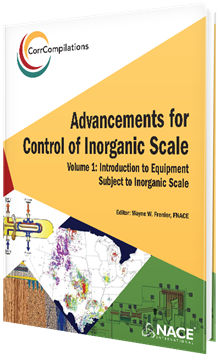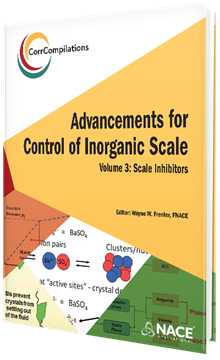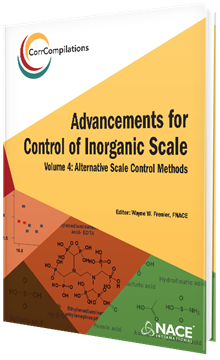This CorrCompilation series focuses primarily on equilibrium-formed scales, where an aqueous fluid changes from an unsaturated equilibrium state to a saturated and supersaturated state and then solids may start to form. These types of fouling minerals include alkaline earth salts, silicates, alkaline salts (NaCl), sulfides, and under specific circumstances, metal sulfide salts that form through equilibrium changes. While corrosion product scales are not the subject of this book, the importance of corrosion product layers to the deposition of other scales will be described.
Since this is a CorrCompilation and more than 90 copies of NACE papers are included, the work is published in four volumes. The editor, Wayne W. Frenier, FNACE, provides an extensive introduction to each volume, offering the reader a thorough mix of history, theory, and engineering techniques and methods for addressing scale.
Volume 1: Introduction to Equipment Subject to Inorganic Scale
Volume 2: Current Mechanisms for Understanding Inorganic Scale Formation and Deposition
Volume 3: Chemistry and Application of Scale Inhibitors
Volume 4: Alternative Methods of Scale Control
Predicting where, when, and, most importantly, how much scale will deposit and adhere to a critical surface has proven to be very challenging. This second volume, "Current Mechanisms for Understanding Inorganic Scale Formation and Deposition," will review literature for both the formation and deposition of the primary fouling mineral scales, CaCO3, CaSO4(X•H2O), BaSO4, metal sulfides, and silica/silicates.
Product Number:
37649-e
ISBN:
978-1-57590-392-7
Author:
edited by Wayne W. Frenier, FNACE
$93.75
$125.00
$125.00
This CorrCompilation series focuses primarily on equilibrium-formed scales, where an aqueous fluid changes from an unsaturated equilibrium state to a saturated and supersaturated state and then solids may start to form. These types of fouling minerals include alkaline earth salts, silicates, alkaline salts (NaCl), sulfides, and under specific circumstances, metal sulfide salts that form through equilibrium changes. While corrosion product scales are not the subject of this book, the importance of corrosion product layers to the deposition of other scales will be described.
Since this is a CorrCompilation and more than 90 copies of NACE papers are attached, the work is published in four volumes. The editor, Wayne W. Frenier, FNACE, provides an extensive introduction to each volume, offering the reader a thorough mix of history, theory, and engineering techniques and methods for addressing scale.
Volume 1: Introduction to Equipment Subject to Inorganic Scale
Volume 2: Current Mechanisms for Understanding Inorganic Scale Formation and Deposition
Volume 3: Chemistry and Application of Scale Inhibitors
Volume 4: Alternative Methods of Scale Control
Predicting where, when, and, most importantly, how much scale will deposit and adhere to a critical surface has proven to be very challenging. This second volume, "Current Mechanisms for Understanding Inorganic Scale Formation and Deposition," will review literature for both the formation and deposition of the primary fouling mineral scales, CaCO3, CaSO4(X•H2O), BaSO4, metal sulfides, and silica/silicates.
Each volume has a summary of current literature on the specific subject based on NACE papers. Abstracts from the editor’s recent books are also utilized as introductions. All of the NACE papers cited in the discussion are included in the compilation and are numbered consecutively. Some papers are cited in multiple volumes because they are relevant to several different aspects of scale deposition and control. Some significant non-NACE papers are discussed and can be found in the reference list.




